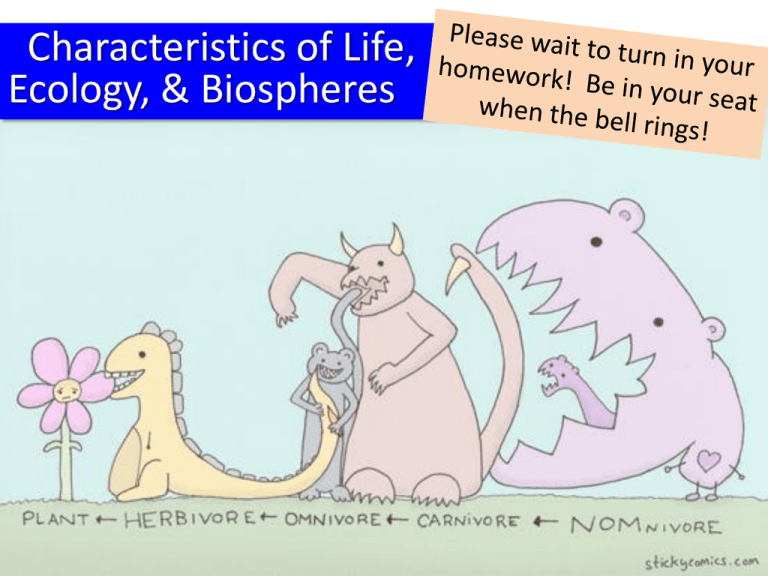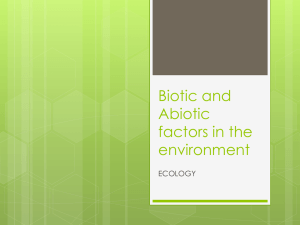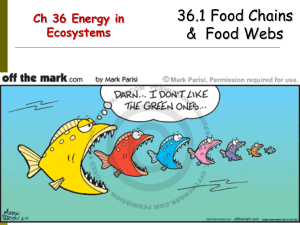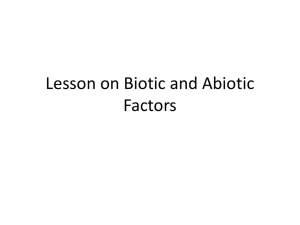Food Webs _ Biospheres
advertisement

Characteristics of Life, Ecology, & Biospheres Please Bring in Pictures of Food! Question of the Day Question: What do you know about biospheres? Answer: … … … Food chain- series of steps in which organisms transfer energy by eating and being eaten Food chain- series of steps in which organisms transfer energy by eating and being eaten Producer- makes energy-rich compounds that are later used by other organisms Food webnetwork of feeding interactions (network of food chains) Primary consumereats producers Secondary consumer- eats primary consumers Tertiary consumer- eats secondary consumers F B I ungi acteria nsects Decomposer- breaks down dead organisms, recycling nutrients 24-Hour Food Log Biosphere: a collection of ecosystems in a closed space In Your Notebook, pp. 65, 67 • P. 65: Draw a circle and label it “Me.” Then, draw five concentric circles and label each of them with the appropriate level of organization. Describe your population, community, etc. Biosphere Biome Ecosystem Community Population Me In Your Notebook, pp. 65, 67 • P. 67: In your own words, explain the difference between biotic and abiotic factors. Give three examples of each. • The difference between biotic factors and abiotic factors is that biotic refers to living and abiotic refers to non-living. Examples of biotic factors include plants, animals, bacteria, and fungi. Examples of abiotic factors include sunlight, air temperature, and precipitation. A.Q. 1ab, 2a, 3ab, 4 on p. 68 • 1a. Question: What are the six different major levels of organization, from smallest to largest, that ecologists commonly study? • 1a. The six different major levels of organization are individual organism, population, community, ecosystem, biome, and biosphere. A.Q. 1ab, 2a, 3ab, 4 on p. 68 • 1b. Question: Give an example of two objects or activities in your life that are interdependent. Explain your choice. • 1b. An example of two activities in my life that are interdependent are cycling and my health. I need a healthy body to cycle and cycling helps maintain a healthy body. A.Q. 1ab, 2a, 3ab, 4 on p. 68 • 2a. Question: Is weather a biotic or abiotic factor? • 2a. Weather is an abiotic factor. A.Q. 1ab, 2a, 3ab, 4 on p. 68 • 3a. Question: Describe the three basic methods of ecological research. • 3a. The three basic methods of ecological research are observing, which is using observations to answer questions about ecology; experimenting, which involves testing a hypothesis in a lab or natural setting; and modeling, which is the use of models, such as mathematical formulas, to answer questions about ecology. A.Q. 1ab, 2a, 3ab, 4 on p. 68 • 3b. Question: Give an example of an ecological phenomenon that could be studied by modeling. Explain why modeling would be useful. • 3b. Global warming is an ecological problem that could be studied by modeling more easily than by observation or experimentation because it occurs over a large area and a long period of time. A.Q. 1ab, 2a, 3ab, 4 on p. 68 • 4. Question: Suppose you want to know if the water in a certain stream is safe to drink. Which ecological method(s) would you use in your investigation? Explain your reasoning and outline your procedure. • 4. To determine if the water in a stream is safe to drink, I would conduct an experiment where 10 water samples are tested at 10 different locations in the stream… Biospheres











